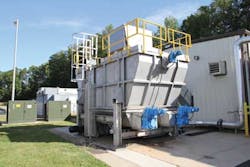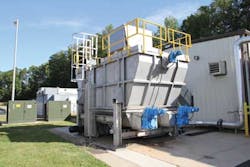Taking the Cake: Cavity Pumps Simplify Drying System Feed
The Town of Mooresville, NC, is using progressive cavity pumps to feed dewatered sludge 80 feet to its dryer to produce "Class A" cake pellets.
By Kathryn Ranger
The Town of Mooresville, NC, is the hub of the Mooresville-South Iredell region, an area that includes Lake Norman, the state's largest man-made lake with 520 miles of shoreline. The town has experienced significant residential and commercial growth in recent years. Since 2000, the population has increased by 74 percent to nearly 33,000 residents.
Mooresville's wastewater goes to the Rocky River Wastewater Treatment Plant (RRWWTP) which began operation in 1982 and is currently expanding. Until 2001, aerobically digested solids were press-dewatered and buried onsite but since then, revised regulations require that solids must be hauled to a landfill for disposal. In 2010, the city began looking for a way to further dry its biosolids in order to reduce freight and landfill costs. Huber Technology's dryer system was selected as a solution for the plant's needs.
During the early design phase of this project, Huber contacted Dave Mangle with Heyward Inc. and Chris Karasch with seepex Inc. for their expertise in pumping dewatered biosolids. seepex's environmental division specializes in "cake" pumps for the controlled transfer of dewatered biosolids. Drawing on past experiences, Mangle and Karasch designed and proposed a complete packaged system for storing and delivering dewatered sludge cake at a uniform rate to the Huber dryer.
After the sludge has been screened and thickened, a belt press squeezes out excess liquid to 18% solids content by weight. The high viscosity dewatered sludge is then conveyed into a seepex live bottom hopper buffer bin that holds 24 hours of product to ensure a consistent supply is sent to the dryer.
Underneath the bin are twin live bottom screws constructed of AISI 304L stainless steel with galvanized carbon steel support columns. Each screw has a five horsepower 3x460x60 vAC drive motor. The screws feed dewatered sludge to two seepex BTES 17-24 progressive cavity cake pumps which then feed product through 80 feet of piping to the dryer.
The system is equipped with a seepex MD 012-24 progressive cavity pump which injects polymer through annular rings for a boundary layer to reduce pressure in the piping. The sludge is then discharged onto a metal belt that travels through to the end of the dryer while being heated to an average temperature of 340° F (170° C). After drying, the final product, 92-97% dry "Class A" cake pellets, travels on a conveyor to a holding area to be loaded onto trucks.
The physical characteristics of the sludge vary and it can be very sticky. The progressive cavity pumps were selected according to the requirements of this application. The twin BTES 17-24 pumps can handle up to 30 gpm at 135 rpm and can handle up to 30 percent dry solids. They are equipped with a TSE device to prevent dry run damage as well as a blinding-off system that makes it easy to replace the rotor or stator without having to empty the bin or make a huge mess underneath the bin.
Distance and high viscosity are not limitations for the MD 012-24 pump which can handle viscosities up to 30,000 cps and incorporates injection rings along the piping. Polymer injection reduces the friction loss from the cake and the resulting discharge pressures by up to 80 percent.
A fully automated control system to match the sludge cake pumps to dewatering equipment output was also included in the package system. The pumps have been running without incident since the system was installed in late 2011. The pumps run continuously four days a week, 24 hours a day. Maintenance costs to date for all three pumps are zero.
About the Author: Kathryn Ranger is Marketing Administrative Assistant for seepex Inc. in Enon, OH. She can be contacted by email at [email protected].

